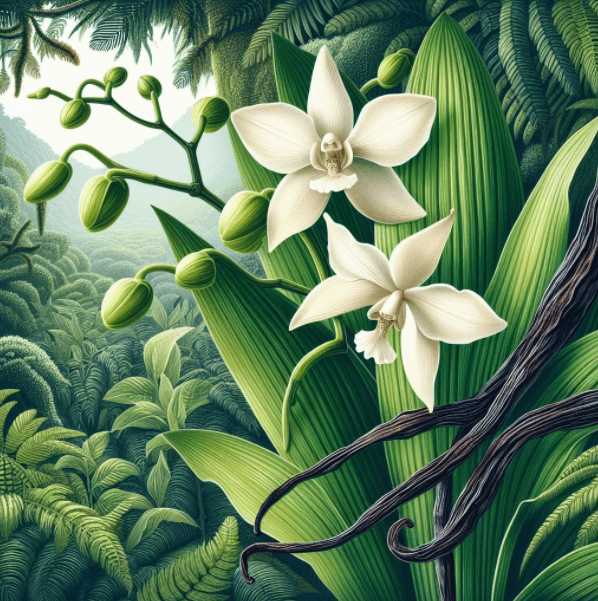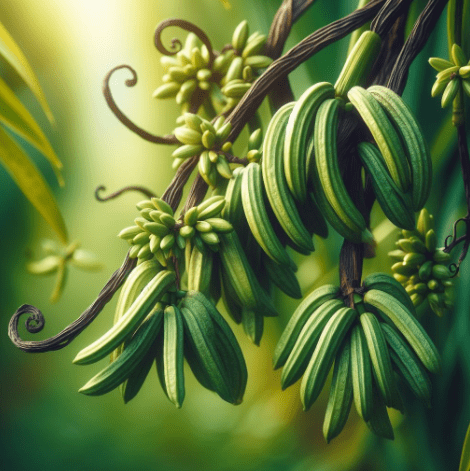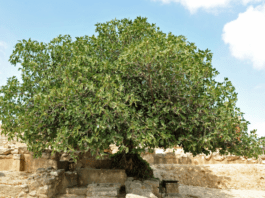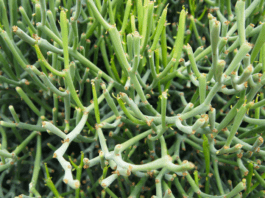
Did you know the flavor of your favorite ice cream comes from the painstakingly cultivated flower of an exotic orchid? Vanilla bean orchids have a rich history. They’re traced back to the tropical rainforests of Mexico, considered by the Aztecs to be the food of the gods. These orchids belong to the genus “Vanilla,” which has over 100 species, but the most commonly cultivated for its flavor comes from Vanilla planifolia.
Caring for Vanilla Bean Orchids at Home
- Light: Bright, indirect sunlight. Mimic the dappled light they’d receive in a rainforest (near an east-facing window or with a sheer curtain is ideal).
- Humidity: Thrive in high humidity (60-80%). Use a humidifier, a pebble tray (pot sits on pebbles in water), or group plants together.
- Support: Vanilla orchids are vines! Provide a trellis or moss pole for them to climb.
- Watering: Water thoroughly when the potting mix feels mostly dry. Avoid soggy roots.
Harvesting and Processing Vanilla Beans

The labor-intensive process of harvesting vanilla beans begins when the pods are plump and green. The ‘Green’ pods need to be treated quite soon after picking, or they will turn brown and spoil. The curing process is crucial in developing their characteristic flavor and aroma.
Traditionally, the beans are heated, dried in the sun during the day, and put in airtight boxes at night for several weeks. This ongoing process is a testament to the effort required for its flavor, which comes from vanilla planifolia, the most popular species for home vanilla cultivation. However, modern methods such as quick drying using ovens and temperature and humidity-controlled rooms are also used to prepare vanilla beans.
Culinary Uses and Health Benefits
Vanilla bean orchids offer much more than just a comforting flavor. The beans are popular in the culinary world due to their use in baking and confectionery. The aromatic compound vanillin is responsible for its distinctive taste and scent and is widely used in various dishes.
In terms of health benefits, vanilla is known for its antioxidant properties and has been traditionally used to help calm the mind and soothe the digestive system. It’s used in aromatherapy and is a common ingredient in various skincare products for its scent.

Vanilla in Culture and Industry
Culturally, vanilla has taken on variegated meanings. Its origin tale with the Aztecs, its imperial use by the Totonacs, and its consumption by European royalty to add flavor to chocolate illustrate its illustrious past.
Today, the vanilla industry grapples with complexities such as market forces driving prices, the challenge of keeping up with synthetic vanillin production, and the overreliance on Madagascar, which is responsible for most of the world’s vanilla. This reliance on one region creates vulnerability, and the high demand for vanilla puts pressure on sustainability.
Thankfully, efforts toward ethical vanilla production and fair-trade practices are growing, offering consumers choices that align with their values.
Conclusion: The Versatile Vanilla Bean Orchid
Vanilla bean orchids stand out for their unique ability to flavor food, provide health benefits, and leave an aromatic trail in various cultural practices. For gardeners willing to invest the time and attention, cultivating this plant could lead to the rewarding harvest of one of the world’s most beloved ingredients.
When grown at home, vanilla bean orchids require a subtropical environment with high humidity, ample sunlight, and well-drained soil. They are mostly epiphytic, meaning they grow on trees in their natural habitats and can be cultivated using a growing medium like bark for a similar effect.
After a few years of growth, vanilla bean orchids produce edible beans with the proper care, and pollination begins to produce edible beans perfect for making homemade vanilla extract.
For vanilla enthusiasts, the allure of this remarkable plant continues to grow, much like the beans it yields. Whether you’re new to gardening, a vanilla fan, or a curious soul seeking to explore a new area of horticulture, vanilla bean orchids offer an irresistible experience waiting to be savored.




